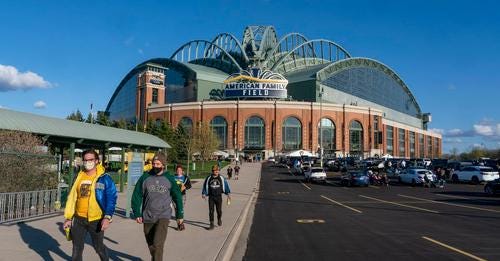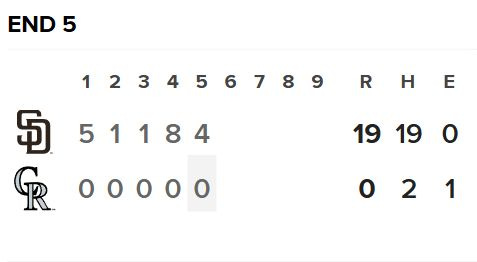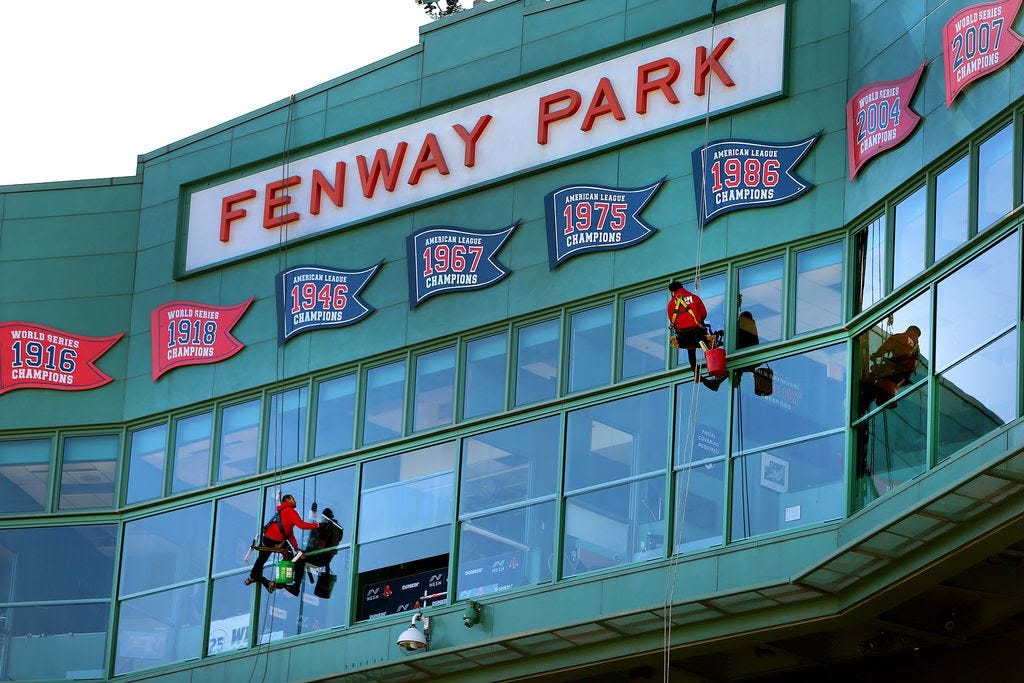IBWAA members love to write about baseball. So much so, we've decided to create our own newsletter about it! Subscribe to Here's the Pitch to expand your love of baseball, discover new voices, and support independent writing. Original content six days a week, straight to your inbox and straight from the hearts of baseball fans.
Pregame Pepper
Did you know…
Seattle closer Anthony Munoz, an avowed animal lover who helps felines in distress, brings his 14-year-old Persian cat Matilda on roadtrips . . .
Rookie Tampa Bay outfielder Chandler Simpson, who scored from second base on an infield hit at Yankee Stadium, compensates for lack of power with blinding speed: he stole 104 bases 110 games in the minors last season . . .
Erstwhile All-Star Jayson Werth was co-owner of the horse that won the 2024 Belmont Stakes . . .
Bo Bichette will represent Brazil in the next World Baseball Classic because that’s the home country of his mother Mariana . . .
Look for erstwhile Atlanta ace Spencer Strider to return to the Braves’ rotation next week, with former MVP Ronald Acuña, Jr. not far behind.
Leading Off
Quinn Priester Developing into an Almost Hometown Boy Makes Good Story, Potentially
By Paul M. Banks
Milwaukee Brewers starting pitcher Quinn Priester was born in Glendale Heights, a western suburb of Chicago, where he grew up to become a Cubs fan. However, it was at Cary-Grove High School where major-league scouts started showing up in droves to see him.
CGHS, according to Google Maps, is an hour and 24 minutes (without traffic) from American Family Field versus one hour and four minutes (without traffic, a concept that simply does not exist in Chicagoland) from Wrigley Field. One could argue that Priester (currently 1-2, 4.59 ERA, 1.56 WHIP, 23 K, 21 BB) is pitching in the major leagues as close to home as possible.
Or at least on the days when Chicago traffic is bad.
Priester was taken in the first round, 18th overall, out of CGHS, by the Pittsburgh Pirates in the 2019 MLB Draft. The Brewers are his third MLB team, after very short stints with the Pirates and Red Sox.
In an exclusive with The Sports Bank, Priester discussed who his pitching role model was as he was coming up through the ranks and named Cubs legend Kyle Hendricks.
"I think he's incredible for doing what he does with the stuff he has," Priester said of the 2016 World Series champion, who also claimed the ERA title (2.13) and finished third in Cy Young award voting that season.
"He started off a little slow, made some changes and now he's awesome, so it's really fun to watch those changes take place and see him get so much success from it."
Priester was really big on Walker Buehler too.
"He's electric, throws hard, spots up, nasty off-speed stuff- so I really enjoy watching him," Priester said of Buehler.
In other words, to be, not the next Kyle Hendricks, nor the next Walker Buehler, but just the best Quinn Priester that he can be, it's all about throwing first pitch strikes. It sounds so simple, and it's just something that is preached from little league up- you want to succeed as a pitcher, you have got to throw strikes.
Priester's 1.1 K/BB ratio leaves a lot to be desired. His career mark of 1.5 is slightly better, but certainly something that leaves a lot of room for improvement. Brewers manager Pat Murphy is very high on Priester, and he has repeatedly said how much he believes in the potential of the 24-year-old.
Priester has definitely been a hard luck pitcher as of late, and in May he's been pitching better than his box scores might indicate. On May 12, he took the L in a 1-0 decision at Cleveland, because the Brew Crew’s run support was simply non-existent on this night.
On May 7, he had another extremely quality start, in another loss, that time to the Houston Astros. Priester was forced to suffer through one bad inning, which began with the middle infield behind him making a major gaffe.
Then there was a passed ball from his batterymate that brought in a run, plus an out- at-the-plate call that got reversed upon review. In short, Priester is just not getting the breaks right now, but when he does, he could truly develop into something special.
He certainly possesses all the talent to someday become The Next Big Thing.
Paul M. Banks is the Founding Editor of The Sports Bank. He’s also the author of “Transatlantic Passage: How the English Premier League Redefined Soccer in America,” and “No, I Can’t Get You Free Tickets: Lessons Learned From a Life in the Sports Media Industry.”
Cleaning Up
Some Teams Won By Two-Dozen Or More Runs
By Dan Schlossberg
When the San Diego Padres embarrassed the home-standing Colorado Rockies by a 21-0 score last weekend, they fell one run short of the record for romps: both the 1975 Pittsburgh Pirates and 2004 Cleveland Indians recorded 22-0 victories.
The Bucs beat the Chicago Cubs by that score on Sept. 16, 1975, while the Indians whipped the Yankees by the same ridiculous but memorable margin — at Yankee Stadium yet — on Aug. 31, 2004.
Two other 21-0 games were shortened for different reasons. On Sept. 15, 1901, Detroit blasted Cleveland in a game shortened to 7 1/2 innings because the Indians had to catch a train to the next town on their schedule.
The other 21-0 score was registered on Aug. 13, 1939, when the Yankees steamrolled the Philadelphia Athletics in the second game of a double-header but called it a night after eight innings because of Sunday Blue Laws then in effect.
Lopsided wins are not uncommon in baseball. But lopsided wins with a run differential of 20 are another story.
The 2007 Texas Rangers actually had a 27-run differential in their August 22 game against the Baltimore Orioles. The Rangers won, 30-3, scoring the most runs of any team during the Modern Era that began with the advent of the American League in 1901.
They were among 20 teams that scored at least 25 runs in a game under the current two-league arrangement.
The Boston Red Sox, thanks to the cozy confines of Fenway Park, scored 29 runs against the St. Louis Browns on June 8, 1950, while the Chicago White Sox plated the same number against the Kansas City Athletics on April 23, 1955.
A National League team, the Atlanta Braves, notched 29 against the Miami Marlins on Sept. 9, 2020 for a league record — one more than the 28 the St. Louis Cardinals got against the Philadelphia Phillies on July 6, 1929. That Braves game, which featured three Adam Duvall home runs, did have a 20-run differential, as the Fish found home plate nine times.
Just for the record, there were eight 19th century games in which the winning team scored at least 30 times. The Chicago White Stockings did it three times but the Chicago Colts scored more often on June 29, 1897, when they whipped the Louisville Colonels, 36-7.
For the record, here are the scores of all Modern Era games in which the winning team scored at least 25 runs:
Texas 30, Baltimore 3, Aug. 22, 2007
Atlanta 29, Miami 9, Sept. 9, 2020
Chicago AL 29, Kansas City 6, April 23, 1955
Boston 29, St. Louis AL 4, June 8, 1950
Toronto 28, Boston 5, July 22, 2022
St. Louis NL 28, Philadelphia NL 6, July 6, 1929
Cleveland 27, Boston AL 3, July 7, 1923
Kansas City Royals 26, Detroit 5, Sept. 9, 2004
Texas 26, Baltimore 7, April 19, 1996
Chicago NL 26, Colorado 7, Aug. 18, 1995
Philadelphia 26, New York NL 7, June 11, 1985
Cleveland 26, St. Louis AL 3, Aug. 12, 1948
New York Giants 26, Brooklyn 8, April 30, 1944
Chicago NL 26, Philadelphia NL 23, Aug. 25, 1922
Cincinnati 26, Boston NL 3, June 4, 1911
L.A. Angels 25, Colorado 1, June 24, 2023
Boston AL 25, Miami 8, June 27, 2003
N.Y. Yankees 25, Philadelphia AL, 2, May 24, 1936
Cleveland 25, Philadelphia AL 7, May 11, 1930
Brooklyn 25, Cincinnati 6, Sept. 23, 1901
New York Giants 25, Cincinnati 13, June 9, 1901
Dan Schlossberg of Fair Lawn, NJ is weekend editor of Here’s the Pitch, national baseball writer for forbes.com, and author of 43 baseball books, including The New Baseball Bible and Home Run King: the Remarkable Record of Hank Aaron. To book him for a presentation, email ballauthor@gmail.com.
Timeless Trivia: More on High-Scoring Games
Texas went scoreless in the first three innings of its 30-3 win at Camden Yards, which was actually the first game of a doubleheader . . .
The Rangers went 18-for-25 (.720) with runners in scoring position . . .
Stadiums didn’t matter: Texas flattened Baltimore by huge margins twice, with the 1996 game at The Ballpark in Arlington and the 2007 game at Camden Yards . . .
When the Braves set the NL mark for most runs in a game, their third-base coach was Ron Washington, manager of the 2007 Texas maulers in Baltimore, while Atlanta’s Nick Markakis got into the game on the losing side, as rightfielder for the O’s . . .
Walt Dropo played in 29-run wins for both the Red Sox in 1950 and the White Sox five years later . . .
The Cardinals had two 10-run innings in their big 1929 win over the Phillies . . .
Cleveland scored in every inning of its blasting of Boston in 1923 . . .
Red Sox reliever Lefty O’Doul gave up 16 runs but only three were earned . . .
Kansas City’s winning pitcher over Detroit in Comerica Park was 20-year-old Zack Greinke . . .
The wind was blowing out at 8-year-old Wrigley Field when the Cubs and Phillies combined for 49 runs, the most ever scored in a single game, with the Phils notching 14 in the last two innings.
Know Your Editors
HERE’S THE PITCH is published daily except Sundays and holidays. Benjamin Chase [gopherben@gmail.com] handles the Monday issue with Dan Freedman [dfreedman@lionsgate.com] editing Tuesday and Jeff Kallman [easyace1955@outlook.com] at the helm Wednesday and Thursday. Original editor Dan Schlossberg [ballauthor@gmail.com], does the weekend editions on Friday and Saturday. Former editor Elizabeth Muratore [nymfan97@gmail.com] is now co-director [with Benjamin Chase and Jonathan Becker] of the Internet Baseball Writers Association of America, which publishes this newsletter and the annual ACTA book of the same name. Readers are encouraged to contribute comments, articles, and letters to the editor. HtP reserves the right to edit for brevity, clarity, and good taste.






